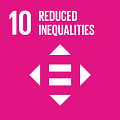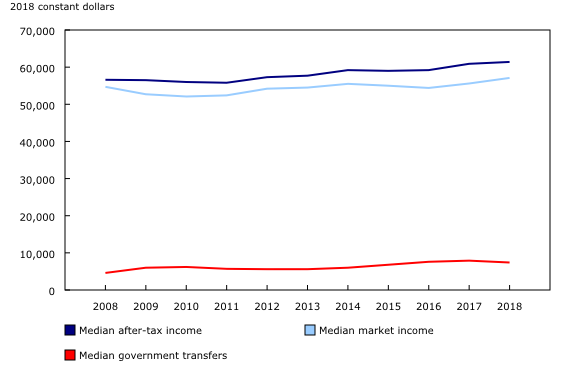Canadian Income Survey, 2018
Archived Content
Information identified as archived is provided for reference, research or recordkeeping purposes. It is not subject to the Government of Canada Web Standards and has not been altered or updated since it was archived. Please "contact us" to request a format other than those available.
Released: 2020-02-24
$61,400
2018
0.8% 
(annual change)
The median after-tax income of Canadian families and unattached individuals was $61,400 in 2018, virtually unchanged from 2017.
For non-senior families, where the highest income earner was under 65 years of age, the median after-tax income was $91,600 in 2018, up $2,300 from 2017. Within this group, couples with children saw their median after-tax income increase by $2,700 to $101,900 in 2018.
The median after-tax income of senior families, where the highest income earner was 65 years of age or older, was $63,500 in 2018, virtually unchanged from 2017. For unattached individuals, the median after-tax income was $30,700 in 2018, unchanged from 2017.
After-tax income increases in Ontario
Similar to 2017, families and unattached individuals in Alberta had the highest median after-tax income ($72,700), while those in Nova Scotia had the lowest ($52,200). The median after-tax income of families and unattached individuals remained relatively stable in every province except Ontario, where it increased by 3.3% to $66,200 in 2018.
Growth in market income for couples with children
After-tax income comprises market income and government transfers. Market income includes employment income, retirement income and income from investments, while government transfers include senior benefits, child benefits, Employment Insurance benefits, social assistance benefits and other benefits.
The growth in after-tax income for non-senior families in 2018 was driven by gains in market income. The main increase was for couples with children, whose median market income rose by $4,400 to $108,700 in 2018.
Median market income of senior families was $40,400 in 2018, little changed from 2017. For unattached individuals, median market income was little changed for both seniors and non-seniors in 2018.
The 2018 increase in after-tax income seen in Ontario was the result of growth in market income. Median market income of families and unattached individuals in Ontario rose by 5.4% to $62,300 in 2018.
Overall poverty rate declines
The market basket measure (MBM) is Canada's Official Poverty Line. According to the MBM, a family lives in poverty if it does not have enough income to purchase a specific basket of goods and services in its community. About 3.2 million Canadians, or 8.7% of the population, lived below Canada's Official Poverty Line in 2018, down from 9.5% in 2017.
For children under 18 years of age, the poverty rate was 8.2% in 2018, little changed from 2017 but continuing a general downward trend since the most recent peak of 15.0% in 2012. In 2018, about 566,000 children lived below the poverty line in Canada, compared with 1 million in 2012.
Children in lone-parent families remain more vulnerable to poverty. In 2018, the child poverty rate was 5.8% for those living in couple families, compared with 26.2% for those in female lone-parent families.
About 216,000 persons aged 65 years and older, or 3.5% of the senior population, lived in poverty in 2018, little changed from 2017. The poverty rate was 1.7% for seniors living in families and 7.9% for unattached seniors.
Review of the market basket measure
Over the last 18 months, Statistics Canada, along with Employment and Social Development Canada (ESDC), has been working towards an update, or "rebasing," of the market basket measure (MBM). The measure is rebased following a comprehensive review, during which prices of the goods and services that make up the basket are updated and, where necessary, methodological changes are also made. A rebasing usually results in a shift upward in the poverty rate, as the poverty thresholds are updated to better reflect contemporary costs of living. Because of the updates that are part of the rebasing, the poverty rates generated by the new base are not directly comparable to the poverty rates generated by the old base.
Today, Statistics Canada is releasing a discussion paper, Report on the second comprehensive review of the Market Basket Measure, which reports on the results of the review up to this point. The purpose of this paper is to promote engagement with users, explain proposed changes to the MBM, and share results. This gives users the opportunity to provide feedback and make suggestions for future work.
Because the comprehensive review is not yet complete, these results should be treated as preliminary.
For clarity, the rebased poverty measure is called the 2018-base MBM, while the existing measure is called the 2008-base MBM. As expected based on the experience of previous rebasings, the 2018-base poverty rate is higher than the 2008-base poverty rate, but shows a very similar trend over the 2015-to-2018 period. The following are some key results:
• The 2008-base poverty rate was 8.7% in 2018, while the 2018-base poverty rate was 11.0% in that year.
• According to the 2008-base poverty line, the number of individuals in poverty declined by 1.06 million from 2015 to 2018 (down 25%). According to the 2018-base poverty line, this number decreased by 1.09 million (down 22%).
• The change in the poverty line between the two bases is due mainly to an update in the cost of shelter included in the MBM basket.
The release of this discussion paper will be followed by a review period during which Statistics Canada and ESDC will engage with experts; stakeholders; and federal, provincial and territorial officials. The transition to the 2018-base MBM will take effect at the end of June 2020.
For more information regarding Canada's Official Poverty Line, refer to Opportunity for All: Canada's First Poverty Reduction Strategy.
No significant changes in the low-income measure in 2018
Statistics Canada also reports low income based on the low-income measure (LIM). The LIM, along with the MBM, is reported as an indicator for the United Nations' Sustainable Development Goals. According to the LIM, individuals live in low income if their household after-tax income falls below half of the median after-tax income, adjusting for household size.
The overall low-income rate based on the LIM was 12.3% in 2018, little changed from 2017. The LIM rate was 12.3% for children and 14.3% for seniors, both virtually unchanged from 2017.
Income inequality
Tracking the shares of income held by the different income deciles can help shed light on income inequality in Canada. For statistics on income inequality, it is common practice to use income measures based on after-tax household income that has been adjusted for household size (adjusted after-tax income). Based on adjusted after-tax income, Canadians in the highest decile accounted for 23.0% of total income in Canada in 2018, while the lowest four deciles (the bottom 40% of the population) represented 20.8%.
From 2017 to 2018, the average adjusted after-tax income rose by 2.5% for persons in the bottom 40% of the income distribution, while it was virtually unchanged for the population as a whole. Since 2012, the growth rate has been 10.4% for those in the bottom 40%, compared with 6.5% for all Canadians.
Sustainable Development Goals
On January 1, 2016, the world officially began implementing the 2030 Agenda for Sustainable Development—the United Nations' transformative plan of action that addresses urgent global challenges over the next 15 years. The plan is based on 17 specific Sustainable Development Goals, 169 targets and 244 indicators.
Data from the Canadian Income Survey are an example of how Statistics Canada supports the reporting on the global Sustainable Development Goals. This release will be used to calculate the market basket measure and low-income measure indicators, which are part of the following goals:


Note to readers
The Canadian Income Survey collected data for the territories for the first time in 2019, for reference year 2018. Results are planned for release this spring.
Please note that with the release of its 2018 estimates, the Canadian Income Survey is also revising some 2017 estimates. A correction was made to the calculation of Quebec income taxes for 2017, leading to revised income tax, after-tax income and low-income measure estimates.
The Canadian Income Survey estimates are based on probability samples and are therefore subject to sampling variability. As a result, estimates will show more variability than trends observed over longer time periods.
In this release, differences between estimates are statistically significant at the 95% confidence level unless otherwise noted.
Definitions
An economic family refers to a group of two or more persons who live in the same dwelling and are related to each other by blood, marriage, common-law union, adoption or a foster relationship. This concept differs from the census family concept used for subprovincial data in the Annual Income Estimates for Census Families and Individuals.
Senior families refer to families where the highest income earner is aged 65 or over.
Non-senior families refer to families where the highest income earner is under 65 years old.
This release analyzes income on the basis of medians. The median is the level of income at which half the population had higher income and half had lower. Income estimates are expressed in 2018 constant dollars to factor in inflation and enable comparisons across time in real terms.
After-tax income is the total of market income and government transfers, less income tax.
Market income consists of employment income and private pensions, as well as income from investments and other market sources.
Government transfers include benefits such as Old Age Security, the Guaranteed Income Supplement, the Canada Pension Plan and the Quebec Pension Plan, Employment Insurance, social assistance, the goods and services tax credit, provincial tax credits, and various types of child benefits.
Income inequality refers to the extent that income is distributed unequally among members of a population. While there are different ways to describe income inequality, this analysis reports on the share of adjusted after-tax income held by various segments of the income distribution. For more information on Sustainable Development Goal 10.1, please refer to The Sustainable Development Goals Report.
For statistics on income inequality, it is common practice to use income measures based on after-tax household income that has been adjusted for household size (adjusted after-tax income). Adjusting for household size allows users to compare the income of households of different sizes. The adjustment is made by dividing household income by the square root of the household size and assigning this value to all persons in the household. This adjustment distributes income among the members of the household, and takes into account the economies of scale present in larger households, the increasing number of individuals living on their own and the decline in family size over time. Adjusted after-tax income is also used in the calculation of the low-income measure.
The low-income measure (LIM) defines an individual as having low income if their adjusted after-tax income falls below 50% of the median adjusted after-tax income.
The market basket measure (MBM) is based on the cost of a specific basket of goods and services representing a modest, basic standard of living. It includes the costs of food, clothing, footwear, transportation, shelter and other expenses for a reference family. These costs are compared with the disposable income of families to determine whether or not they fall below the poverty line.
Products
The infographics "Canada's Official Poverty Dashboard, February 2020" and "Canada's Official Poverty Dashboard: Snapshot, February 2020" are now available.
The Report on the second comprehensive review of the Market Basket Measure is also now available.
Contact information
For more information, or to enquire about the concepts, methods or data quality of this release, contact us (toll-free 1-800-263-1136; 514-283-8300; STATCAN.infostats-infostats.STATCAN@canada.ca) or Media Relations (613-951-4636; STATCAN.mediahotline-ligneinfomedias.STATCAN@canada.ca).
- Date modified:


